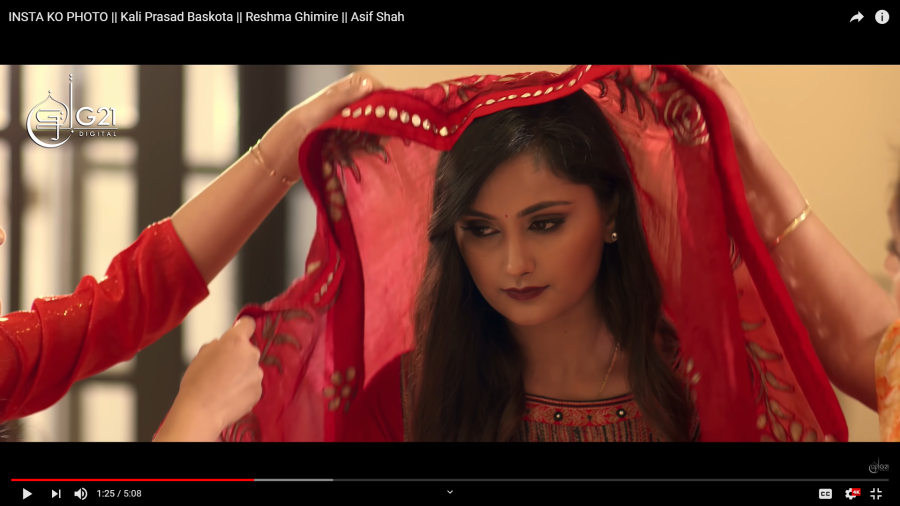Culture & Lifestyle
TikTok: a showreel for Nepal’s aspiring performers
As TikTok videos continue to clog the internet, they are helping performing artists build their careers.
Abani Malla
Before pressing play, Reshma Ghimire’s face is instantly recognisable—at least for frequent TikTok users. Sitting on the floor at the end of her bed, the video begins with her sobbing and checking her phone repeatedly. The video transitions softly and slowly, ending with her embracing an equally sorrowful and teary-eyed Asif Shah.
Directed by Asim Shah, Kali Prasad Baskota’s single Insta ko photo went viral within a few days of release and has garnered more than 11 million views. Ghimire started her journey towards acting with TikTok, but her popularity pulled her from the app into mainstream entertainment. Director Shah came across Ghimire’s TikTok videos and was struck by how “powerfully” delivered her dialogues were. He saw potential. Not long after, he contacted and offered Ghimire a role in the project.
TikTok videos are now all over the internet, occupying many social media feeds, resulting in not just the videos going viral, but the application itself too. Even if the videos keep clogging everyone’s feeds, the app isn’t just limited to being a “fun” platform anymore. For some audiences, Tiktok could be annoying, but for entertainers in Nepal, it has become a portfolio of sorts, and for filmmakers, a modern and informal audition.
Before emerging as a TikTok sensation, 23-year-old Ghimire had already played in a movie and won the Miss Purwanchal 2014 crown. Ghimire had a passion for performing since she was in school and while her accomplishments did help her experience her dreams to an extent, it was TikTok that made her dreams a reality.
Even though Ghimire, who goes by @reshmaghimire on TikTok, was the first Nepali user to be ‘verified’ as a popular creator on the platform, her intentions were not exactly fame-driven.
“I didn’t start making TikTok videos for fame,” says Ghimire, “But eventually, people loved them and that helped me build connections with directors.”
Ever since it was acquired and rebranded by Chinese company ByteDance, in November 2017, TikTok became a viral photo and video app. Formerly known as Musical.ly, TikTok’s core features replicate Dubsmash—popular in 2016—but rich editing features and libraries of customisable audio enable users to easily lip-sync and perform.
TikTok has become a portfolio for twins Amar and Amrit Dahal as well. Being a theatre actor for four years, 22-year-old Amrit recognises that he only received mass attention after uploading videos on TikTok with his brother. If he hadn’t done the videos, he may not be as well-known, for he lacked the visibility that affords him all his current opportunities.
“We have received some offers to debut on music videos and commercials after people watched our TikTok videos,” says Amrit, who curates @dahal_twins on TikTok with brother Amar.
Because of the opportunity that comes with TikTok fame, creators told the Post that they are conscious of the content they post and very particular of their performance.
The added features make creating content a lot easier, and visual filters make Ghimire’s work and production more efficient, she says. But she is still a stickler for getting it right—she retakes videos plenty of times to deliver a worthy performance. The Dahal twins agree, as they often reshoot videos from scratch if they’re substandard.
“As I can see myself perform right away, I get to be critical of my performance too,” says Amrit.
TikTok has been linking upcoming aspiring performers, filmmakers, and their audience digitally with ease. Director Shah says that while the application provides a platform for aspiring entertainers to perform, filmmakers are using the app to usher in “extraordinary talent” into the mainstream media.
Shah not only found Ghimire through TikTok, but also collaborated with Shikshya Sangraula and Barsha Raut because they were both suggested to him for their performances’ popularity on the viral application.
“Before, we had to advertise our auditions on television and print media,” says Shah. “Now, the process has become much easier thanks to applications like TikTok.”
For director Pradeep Bhattarai, TikTok was where he found Indira Magar for a role in the movie Jatrai Jatra.
The confirmation if an actor can meet the needs of a role can be made by seeing them deliver dialogue, says Bhattarai. Viewing Magar’s TikTok profile helped him determine if she was competent or not. And it made things even easier as Magar was based in Australia—where the film was shot—during the time of audition.
However, the application’s charm hasn’t only enticed youths and brought new-comers to the limelight. Even established actors like Priyanka Karki, Barsha Raut, and Aanchal Sharma are active on Tiktok.
“Making such videos help me practice my facial expressions,” says Aanchal Sharma. “I also became more camera-friendly once I started using the application.”
Due to the vast content present on the application, videos on TikTok are usually anything between being borderline cringy and outstanding. And it takes a lot of surfing to get to the good videos of one’s preferences. Creators love what they’re doing, but even they don’t seem to understand the sorcery in TikTok’s algorithm.
“Any kind of video goes viral on TikTok,” says Ghimire. “Sometimes that demotivates people who have put in extra effort, as even random videos receive a lot of attention.”
Because of their frequent use of the application, creators have experienced phases of addiction to TikTok. Even if it’s a great platform, one needs to understand when and for how long should they use it, says Ghimire, recalling how she was almost hit by a vehicle for the sake of creating a video.
Even if the application has both positives and negatives, especially on users, performing artists acknowledge it’s still a virtual stage for them to grow.
“For emerging artists, TikTok is an amazing platform,” says Amrit. “But one should use it sparingly to avoid any negative consequences it might develop within them.”
***
What do you think?
Dear reader, we’d like to hear from you. We regularly publish letters to the editor on contemporary issues or direct responses to something the Post has recently published. Please send your letters to [email protected] with "Letter to the Editor" in the subject line. Please include your name, location, and a contact address so one of our editors can reach out to you.




 11.12°C Kathmandu
11.12°C Kathmandu













%20(1).jpg&w=300&height=200)

